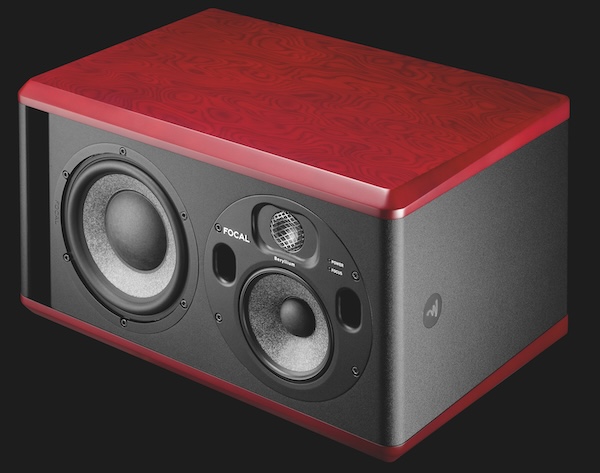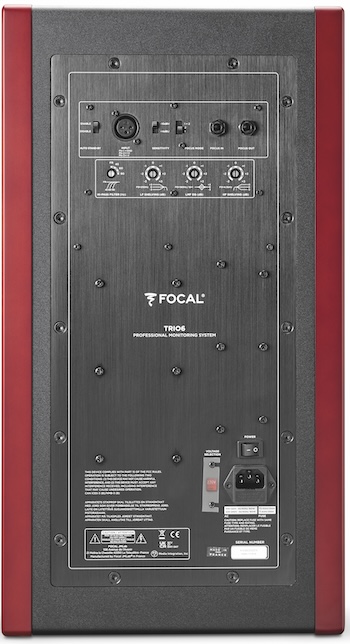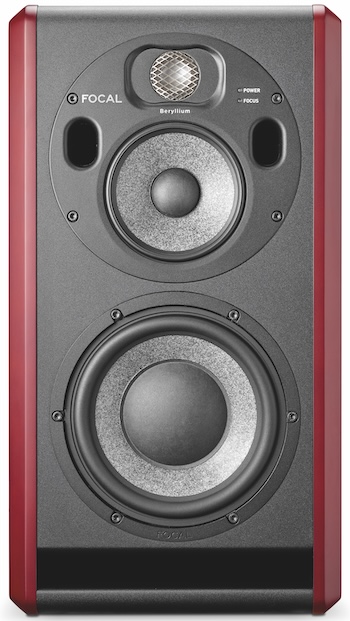
Barry's Mix Magazine Equipment And Software Reviews
Barry's Massive Discography And Engineering Career
Barry's Music Connection Magazine Reviews
Barry's Resolution Magazine Reviews
Focal Professional Trio6 ST6
Three-way monitor that's smooth, musical and focused
By Barry Rudolph
 |
| Focal Professional Trio6 ST6 Studio Monitor |
Designed and made in France, the now-redesigned Focal Trio6 ST6 is a beautiful-looking three-way studio monitor and the latest addition to Focal’s ST6 range, which includes the Solo6, the 2.5-way Twin6, and the powered Sub12 subwoofer--all released in 2022.
The Trio6 ST6 has an internally-braced, black cabinet made from 22-mm (7/8-inch) MDF and comes with dark-red, natural ash veneered side panels. A single Trio6 monitor measures: 53.7 H X 29.2 L X 36.9 D cm and weighs 25-kg or about 55-pounds.
A carefully designed laminar port, minimizes chuffing and noise; it is located on the front of the cabinet just below the 20.3cm (8-inch) woofer. The woofer uses Focal’s patented, composite W-cone design and has a frequency response down to 35Hz. Directly above it is a 12.7cm (5-inch) midrange driver that uses a tuned-mass damper to reduce distortion in the 1 to 3kHz range.
A 2.5cm (1-inch) inverted-dome tweeter made from Beryllium extends this monitor’s frequency range out to 40-kHz with very little beaming directionality. Mostly used in aerospace applications, Beryllium (Be, atomic number 4) is a strong, lightweight metal and a strong wire mesh is used to protect this tweeter.
Studio and Setup
I am a freelance engineer/mixer/producer and work in a small room that is approximately 2.89-m (9.5-feet) wide and 5.76m (18.9-feet) long. The ceiling height is 2.49m (8.1-feet). My pair of Trio6 ST6 monitors each sit on a set of four Iso-Acoustics Iso-Puck 76 vibrational isolators. The Trio6 and Iso-Pucks sit atop 431-mm (17-inch) square pieces of 19mm (3/4-inch) thick wood planks on the top of my Sound Anchor Speaker Stands (Model ADJ2).
Through years of experience and experimentation with other professional monitor speakers, I’ve found the optimum distance to the L/R side walls that minimizes speaker-boundary interference response (SBIR) is about 0.82m (32-inches). This distance doesn’t compromise stereo width and imaging. The distance from the front wall (behind the monitors) is 0.68m (27-inches) measured from the center of the Trio6’s rear panel/heatsink.
The monitors are 1.16-m (46-inches) above my hardwood floor. The L/R monitors are 1.16-m apart (46-inches) measured from the center of each woofer, completing the front side of an equilateral triangle with the optimum listening position located at the third corner out front and in the exact center of the room's width dimension. Both monitors are vertically oriented and "toed-in" or angled inward slightly towards the listening position.
Focal recommends that the mid-range/tweeter plate be head height but for my clients and musicians usually standing behind me while listening, as a consideration, I have them a little higher up. The entire mid-range/tweeter plate can be rotated in 90-degree increments for horizontal positioning.
(NOTE: I did not test the Trio6 ST6 in horizontal orientation as I do not have the room on my stands and, while in that position, there is not enough L/R distance from my side walls to allow for it without creating a greater SBIR problem.)
Electronics and Rear Panel
 |
| Rear Panel Of The Trio6 ST6 |
Nearly the entire back metal panel of the Trio6 is used as a heatsink for the three power amplifiers. There are switches for changing the Input sensitivity to either +4dBu or -10dBV using the same XLR input connector. The bass and mid-range amplifiers are rated at 100-watts RMS each running Class-G while the tweeter's Class-AB amplifier is rated at 50-watts. There is also an Auto Standby enable/disable switch on the rear panel. Auto Standby will "wake up" the monitors from power saving sleep mode (front-panel red LED) as soon as audio input is detected.
I especially liked that there is a four-position rotary switch for the high-pass filter knee (-3dB starting at 150Hz). Low frequency modal resonances--extreme peaks and nulls--always present the biggest problems, especially in small rooms. Here there are four choices: flat, 45, 60, and 90Hz.
There are three more pots to adjust (+/- 3dB) three equalizers for the incoming audio signal. A low-frequency shelving equalizer starts at 250-Hz; the mid-range EQ is a low Q peaking type (Q=1) with a center frequency of 160Hz; and the high frequencies are covered with a shelving equalizer starting at 4.5-kHz.
Until I acoustically re-measure my room and/or add the Sub12 ST6 Subwoofer to make a 2.1 system, for now, I left all these controls in their flat position(s). I certainly like the option to measure my room and carefully adjust these additional controls as required.
Dual Focus Mode
Focus Mode is a feature in the Solo6 ST6, Twin6 ST6 and now the Trio6 ST6 monitor systems. The Focal Trio6 ST is unique in that it has a Dual Focus Mode making it three monitor systems in one cabinet.
Dual Focus Mode offers two different known "constrained" frequency ranges for monitoring audio using only high-pass filters. These two modes offer a way to check how my music mixes hold up when played on much lower fidelity systems--smaller speakers or over a streaming service.
Focus Mode keeps the imaging and stereo positioning solid, relative to the fixed listening position. This is unlike when using a second set of monitors that have to be placed (physically) either too wide left and right of your mains for an unrealistic stereo width or positioned too close together for a compromised stereo image and center-channel buildup.
Called Focus 1 + 2, the three-way Trio6 ST6 is a full-range system with a frequency range of 35-Hz to 40-kHz (-3dB).
Focus Mode 1 has a 100-Hz to 15-kHz response and uses only the mid-range driver with a separate 100Hz high-pass filter for a one-way system that also shuts down both the tweeter and woofer.
Focus Mode 2 is specified at 80Hz to 40kHz and uses the tweeter and the mid-range drivers together as a two-way system but with a different crossover circuit than the three-way system and shuts down the woofer. Which Focus Mode is active is indicated by a bi-colored front panel LEDs located just under the Power LED. Focus Mode 1 lights a green LED and Focus Mode 2 lights an orange LED.
On the back panel of each speaker are 1/4-inch TRS jacks for cables to link any number of Focal monitors and Subwoofers (ATMOS/Immersive systems) together so that they all switch Focus modes at the same time.
For this review Focal supplied a Boss® FS-6 dual-footswitch (the proper model to use) and the necessary cabling--however Focal does not make or include a footswitch with your purchase. But footswitch wiring is very simple and controls relays inside of the Trio6 ST cabinet; later, I built my own switch box for my desktop.
In The Studio
 |
| Focal Trio6 ST6 Vertical Positioning |
My studio mix room has extensive acoustic treatment that includes two PSI Audio AVAA C20 Active Bass Traps sitting on the floor in each front corner, with a stack of conventional bass traps and panels above them going to the ceiling. There are two, thick absorptive ceiling clouds above the listening position, large absorption panels on the walls left and right of the listening position as well as both quadratic residue and poly-cylindrical diffusors on the ceiling and positioned also on the rear wall.
After Focal’s recommended 40-hour "run-in" period, I have had the opportunity to use this pair of Trio6 ST6 monitors for about six weeks, now using them every day for both my music mixing and also my lengthy Grammy voting process of listening and recording each nominee over the course of about five, long days.
This worked well as a run-in period to acquaint myself with these monitors playing all kinds of music genres. I found it easy to develop a good relationship with these monitors and soon, I felt I could trust them.
Mixing Music and Using Focus Mode
From the first time I listened to them, there is no doubt that the Focal Trio6 monitors sound great! They are smooth and accurately reproduce transients and all frequencies in a musically balanced way.
For mixing music professionally, they make excellent "sonic microscopes" that made typical problems such as: phase/polarity anomalies, distortion, stereo imaging, and over-compressed individual tracks immediately hearable even without soloing them. I later verified the suspected phase/polarity issues (even heard on finished, mastered CDs, and vinyl records) using my good old, 465B Tektronix lab oscilloscope--but I first heard them clearly on the Trio6 ST6 monitors!
I have to admit I was highly skeptical about the utility of the Focus Modes, but I am using it now as part of my regular process when starting new mixes--it is especially useful for music/songs I didn’t record.
Focus Mode 1 (green) is much brighter and little thinner sounding and useful to hear full mixes at very low volume as if played on small speakers.
Focus Mode 2 (orange) is full range except for less bass as you would hear on small speakers. I use it for equalizing, layering and mixing mid-range guitars and keyboard instruments all (temporarily) panned to the center.
I am excited to have these Trio6 ST6 monitors in my studio; they are excellent tools and, with them, I continue to improve my mixing process and achieve better results. I can highly recommend these monitors that look as great and they sound.
|
|
|
|
|